
When I was younger and began noticing persistent stomach issues and random aches and pains, I was often told it was “all in my head.” At the time, that label—hypochondriac—carried a sense of dismissal, as if my symptoms weren’t real or worth investigating.
But science has come a long way. Over the past fifteen years, research has begun to validate what many of us have intuitively known: a great deal of physical pain is connected to the head—just not in the way people once thought. You see, the brain is an integral part of the nervous system, and it plays a key role in how we perceive and interpret pain.
Pain is not always a direct signal of damage
It’s a complex conversation between the brain, the spinal cord, and the body. Sensory information from the body travels through the nervous system, gets filtered through the brain, and then creates the sensation we label as pain. If that communication system is out of sync—due to trauma, chronic stress, or past injury—those signals can become distorted. The result? We might feel pain where there’s no injury or feel it more intensely than the situation warrants.
This is especially true when the nervous system has been sensitized by past experiences. It’s like the volume knob has been turned up. Pain becomes louder, more persistent, and often less specific.
In Somatic Yoga, we work directly with this system. We create a gentle, supportive environment that encourages the brain and body to re-establish clear lines of communication.
Through mindful movement, breath, and sensory awareness, we help the nervous system downshift from high alert into a state of safety and regulation. Over time, this can reduce pain, improve mobility, and enhance the overall sense of well-being.

How Does Somatic Yoga Signal Safety to the Brain?
In Somatic Yoga, the focus is on sensing the body—feeling the subtle sensations as you gently contract and release muscles. Instead of stretching, this approach sends a calming signal through the vagus nerve to the brain, letting it know that it’s safe to move an area that may be chronically tense. Experience it for yourself with this 15-minute snippet of a Somatic Yoga class and notice how it feels in your body.
Did you notice how this practice feels different from a typical yoga class?
By using subtle, slow, and intentional contractions and releases, you’re helping to re-establish safe and healthy communication throughout your nervous system. This gentle approach isn’t just a one-time fix—it’s a practice that builds over time, creating lasting shifts in how you feel and move in your body.
If you’re curious to experience more, I’d love for you to join me! I offer live online Somatic Yoga classes every Tuesday and Thursday at 8:15 AM ET, and recordings are available for on-demand viewing if that time doesn’t work for you.
✨ Sign up and connect with me at by clicking here.
✨ Let’s explore what it feels like to move with more ease, awareness, and connection.


